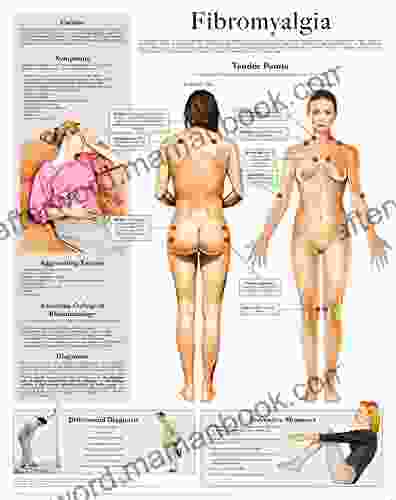Fibromyalgia Chart Full Illustrated: Detailed Guide to Symptoms, Causes, and Treatment

Fibromyalgia is a chronic condition that causes widespread pain and tenderness in the muscles, tendons, and ligaments. It can also lead to fatigue, sleep problems, and cognitive difficulties.
The fibromyalgia chart is a tool that can help you track your symptoms and identify potential triggers. It can also be used to communicate with your doctor about your condition.
This article provides a detailed illustration of the fibromyalgia chart, covering all aspects of the condition, including symptoms, causes, and treatment options.
4.3 out of 5
| Language | : | English |
| File size | : | 4514 KB |
| Text-to-Speech | : | Enabled |
| Screen Reader | : | Supported |
| Enhanced typesetting | : | Enabled |
| Word Wise | : | Enabled |
| Print length | : | 16 pages |
| Lending | : | Enabled |
The most common symptom of fibromyalgia is widespread pain. This pain can be described as aching, throbbing, or burning. It can range from mild to severe and can affect any part of the body.
Other common symptoms of fibromyalgia include:
- Fatigue
- Sleep problems
- Cognitive problems
- Headaches
- Irritable bowel syndrome
- Depression
- Anxiety
The symptoms of fibromyalgia can vary from person to person. Some people may only experience a few of these symptoms, while others may experience many.
The exact cause of fibromyalgia is unknown. However, it is thought to be caused by a combination of genetic, environmental, and psychological factors.
Some of the potential causes of fibromyalgia include:
- Genetics: Fibromyalgia tends to run in families, suggesting that there may be a genetic component to the condition.
- Environmental factors: Certain environmental factors, such as exposure to toxins or trauma, may trigger the onset of fibromyalgia.
- Psychological factors: Stress, anxiety, and depression can all contribute to the development of fibromyalgia.
There is no single test that can diagnose fibromyalgia. Instead, your doctor will diagnose fibromyalgia based on your symptoms and a physical exam.
Your doctor may also order some tests to rule out other conditions that may be causing your symptoms. These tests may include:
- Blood tests
- Imaging tests
- Nerve conduction studies
There is no cure for fibromyalgia, but there are a number of treatments that can help to manage the symptoms. These treatments may include:
- Medication: There are a number of medications that can help to relieve the pain and fatigue associated with fibromyalgia. These medications include pain relievers, antidepressants, and anticonvulsants.
- Physical therapy: Physical therapy can help to improve flexibility, range of motion, and strength. This can help to reduce pain and improve function.
- Occupational therapy: Occupational therapy can help you to learn how to manage your symptoms and perform everyday activities more easily.
- Cognitive-behavioral therapy: Cognitive-behavioral therapy can help you to change the way you think about your pain and learn how to cope with it more effectively.
- Lifestyle changes: There are a number of lifestyle changes that can help to manage fibromyalgia symptoms. These changes include getting regular exercise, eating a healthy diet, and getting enough sleep.
The fibromyalgia chart is a tool that can help you to track your symptoms and identify potential triggers. It can also be used to communicate with your doctor about your condition.
The fibromyalgia chart includes the following information:
- Date: The date on which you are experiencing symptoms.
- Time: The time of day at which you are experiencing symptoms.
- Location: The location of your pain.
- Severity: The severity of your pain.
- Triggers: Any potential triggers that may have caused your symptoms.
- Other symptoms: Any other symptoms that you are experiencing.
You can use the fibromyalgia chart to track your symptoms for a period of time, such as a week or a month. This can help you to identify patterns in your symptoms and determine what factors may be triggering them.
You can also use the fibromyalgia chart to communicate with your doctor about your condition. Your doctor can use the chart to track your progress and make adjustments to your treatment plan as needed.
The fibromyalgia chart is a valuable tool that can help you to manage your symptoms and improve your quality of life. By using the chart to track your symptoms and identify potential triggers, you can work with your doctor to develop a treatment plan that is right for you.
4.3 out of 5
| Language | : | English |
| File size | : | 4514 KB |
| Text-to-Speech | : | Enabled |
| Screen Reader | : | Supported |
| Enhanced typesetting | : | Enabled |
| Word Wise | : | Enabled |
| Print length | : | 16 pages |
| Lending | : | Enabled |
Do you want to contribute by writing guest posts on this blog?
Please contact us and send us a resume of previous articles that you have written.
 Top Book
Top Book Novel
Novel Fiction
Fiction Nonfiction
Nonfiction Literature
Literature Paperback
Paperback Hardcover
Hardcover E-book
E-book Audiobook
Audiobook Bestseller
Bestseller Classic
Classic Mystery
Mystery Thriller
Thriller Romance
Romance Fantasy
Fantasy Science Fiction
Science Fiction Biography
Biography Memoir
Memoir Autobiography
Autobiography Poetry
Poetry Drama
Drama Historical Fiction
Historical Fiction Self-help
Self-help Young Adult
Young Adult Childrens Books
Childrens Books Graphic Novel
Graphic Novel Anthology
Anthology Series
Series Encyclopedia
Encyclopedia Reference
Reference Guidebook
Guidebook Textbook
Textbook Workbook
Workbook Journal
Journal Diary
Diary Manuscript
Manuscript Folio
Folio Pulp Fiction
Pulp Fiction Short Stories
Short Stories Fairy Tales
Fairy Tales Fables
Fables Mythology
Mythology Philosophy
Philosophy Religion
Religion Spirituality
Spirituality Essays
Essays Critique
Critique Commentary
Commentary Glossary
Glossary Bibliography
Bibliography Index
Index Table of Contents
Table of Contents Preface
Preface Introduction
Introduction Foreword
Foreword Afterword
Afterword Appendices
Appendices Annotations
Annotations Footnotes
Footnotes Epilogue
Epilogue Prologue
Prologue Nadia Maddy
Nadia Maddy Yusuke Murata
Yusuke Murata David A White
David A White Ron Rash
Ron Rash Rick Najera
Rick Najera Ed West
Ed West Steven F Lott
Steven F Lott Gavin Francis
Gavin Francis Gi Gi
Gi Gi John Lescroart
John Lescroart Frank Rutledge
Frank Rutledge Robert R Prechter
Robert R Prechter Frank Rudnesky
Frank Rudnesky Will Duffy
Will Duffy Heather Mills Schwarzen
Heather Mills Schwarzen Stanley I Grossman
Stanley I Grossman J Callous
J Callous Jennifer Michaels
Jennifer Michaels Julie Bogart
Julie Bogart Phil O Viljoen
Phil O Viljoen
Light bulbAdvertise smarter! Our strategic ad space ensures maximum exposure. Reserve your spot today!

 Nathaniel HawthorneThe Easiest and Quickest Way to Learn Python Programming for Web Development...
Nathaniel HawthorneThe Easiest and Quickest Way to Learn Python Programming for Web Development... Christian BarnesFollow ·19.4k
Christian BarnesFollow ·19.4k Enrique BlairFollow ·14.7k
Enrique BlairFollow ·14.7k Cristian CoxFollow ·3.7k
Cristian CoxFollow ·3.7k Owen SimmonsFollow ·8.3k
Owen SimmonsFollow ·8.3k Henry HayesFollow ·2k
Henry HayesFollow ·2k Davion PowellFollow ·16.7k
Davion PowellFollow ·16.7k Eugene PowellFollow ·11.8k
Eugene PowellFollow ·11.8k Leslie CarterFollow ·11.2k
Leslie CarterFollow ·11.2k

 Bryce Foster
Bryce FosterViolin Is Easy: A Comprehensive Guide for Beginners
The violin is a...

 Cristian Cox
Cristian CoxThe True Story Of The Ivy League Cowboys Who Raided The...
In the early 2000s, a group of Ivy League...

 Ken Follett
Ken FollettUnraveling the Enchanting World of Menewood: A...
Embark on an enthralling...

 Phil Foster
Phil FosterNorth Poems by Seamus Heaney: An Exploration of Place,...
Seamus Heaney's North...

 Jack Butler
Jack ButlerFleeting Encounters: The Enigmatic Transience of Maria...
In the annals of literary history, fleeting...

 Eliot Foster
Eliot FosterA Haiku Summer: Capturing the Essence of the Season in...
Summer is a time of warmth,...
4.3 out of 5
| Language | : | English |
| File size | : | 4514 KB |
| Text-to-Speech | : | Enabled |
| Screen Reader | : | Supported |
| Enhanced typesetting | : | Enabled |
| Word Wise | : | Enabled |
| Print length | : | 16 pages |
| Lending | : | Enabled |








